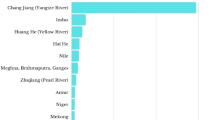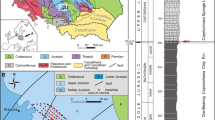Abstract
The new sediment slicer described herein provides an easy and time-efficient way of sectioning cores of varying length, diameter, and composition from a wide range of habitats and sediment types. It is designed to process sediments collected by means of any soft-sediment core sampler with the core tube detachable from the sampler head and trigger unit. It is useful for sectioning core samples that include both the undisturbed sediment/water interface and highly consolidated sediments. The slicer is composed of three parts: (1) a supporting block, (2) a gliding block with the incorporated 10 cm sub-sampler holder designed to glide freely in the grooves along the supporting block, and (3) a metal blade for sediment slicing.



Similar content being viewed by others
References
Blomqvist S (1991) Quantitative sampling of soft-bottom sediments. Problems and solutions. Mar Ecol Prog Ser 72:295–304
Feek DT, Horrocks M, Baisden WT, Flenley J (2011) The Mk II sampler: a device to collect sediment cores for analysis of uncontaminated DNA. J Paleolimnol 45:115–119
Gąsiorowski M (2008) Deposition rate of lake sediments under different alternative stable states. Geochronometria 32:29–35
Glaser PH, Griffith M (2007) A field extruder for rapidly sectioning near-surface cores from lakes and wetlands. J Paleolimnol 39:459–466
Glew JR (1988) A portable extruding device for close interval sectioning of unconsolidated core samples. J Paleolimnol 1:235–239
Glew JR, Smol JP, Last WM (2001) Sediment core collection and extrusion. In: Last WM, Smol JP (eds) Tracking environmental change using lake sediments, vol 1. Kluwer Academic Publishers, Dordrecht, pp 73–105
Halkiewicz A (2005) Subfossil remains of Chironomidae from two shallow lakes representing extreme alternative states. Studia Quaternaria 22:45–49
Kaczorowska A, Kornijów R (2012) Palaeoecological evidence for changes over the past 200 years in chironomid communities of a shallow lake exposed to cyanobacterial toxins. Aquat Ecol. doi:10.1007/s10452-012-9415-y
Kornijów R (1997) The impact of predation by perch on the size structure of Chironomus larvae—effect of prey vertical distribution and habitat complexity. Hydrobiologia 342(343):207–213
Kornijów R (2009) Sectioning device. Patent no. A1 8383855. J Pat Off Pol 11:21
Kornijów R, Halkiewicz A (2007) Are the larvae of Propsilocerus lacustris Kieffer 1923 (Diptera, Chironomidae) favoured by nutrient-rich lakes? Aquat Insect 29:187–194
Kornijów R, Moss B (1998) Vertical distribution of in-benthos in relation to fish and floating leaved macrophyte population. In: Jeppesen E, Sondergaard M, Sondergaard M, Christoffersen M (eds) The structuring role of submerged macrophytes in lakes. Ecological Studies 131. Springer, Berlin, pp 227–232
Kornijów R, Szczerbowski JA, Krzywosz T, Bartel R (2001) The macrozoobenthos of the Iraqi lakes: Tharthar, Habbaniya and Razzazah. Arch Pol Fish 9 Suppl 1:125–143
Niemistö L (1974) A gravity corer for studies of soft sediments. Merentutkimuslait. Julk/Havsforskningsinst. Skr. 238:33–38
Pawlik-Skowrońska B, Kornijów R, Pirszel J (2010) Sedimentary imprint of cyanobacterial blooms—a new tool for insight into recent history of lakes. Pol J Ecol 58:663–670
Schumacher B (2005) Collection of undisturbed surface sediments: sampler design and initial evaluation testing. U.S. environmental protection agency office of research and development. Washington, DC 20460. http://www.epa.gov/esd/cmb/pdf/USS_Sampler_FINAL_REPORT.pdf
Uwitec Corer. http://www.uwitec.at/html/frame.html
Verschuren D (1993) A lightweight extruder for accurate sectioning of soft-bottom lake sediment cores in the field. Limnol Oceanogr 38:1796–1802
Winterhalter B (2001) GEMAX—The ultimate corer for soft sediments. www.kolumbus.fi/boris.winterhalter/GEMAX.pdf
Wright HE Jr (1991) Coring tips. J Paleolimnol 6:37–49
Acknowledgments
The work was partly supported by the State Committee for Scientific Research, project No. P06S00127. My thanks are due to Małgosia Kornijów for English corrections to the paper, to Leszek Błędzki for valuable comments on the first draft of the manuscript, and to Elizabeth Gross for inviting me to Limnological Institute, University of Konstanz, where the prototype of the sampler was produced.
Author information
Authors and Affiliations
Corresponding author
Rights and permissions
About this article
Cite this article
Kornijów, R. A new sediment slicer for rapid sectioning of the uppermost sediment cores from marine and freshwater habitats. J Paleolimnol 49, 301–304 (2013). https://doi.org/10.1007/s10933-012-9655-9
Received:
Accepted:
Published:
Issue Date:
DOI: https://doi.org/10.1007/s10933-012-9655-9




